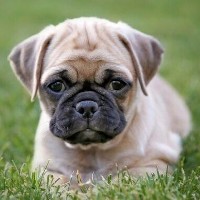Appearance of the Box-a-Pug
|
| The Box-a-Pug is a small to medium-sized breed, depending on which of the parent breeds is the most dominant. They can be light brown, fawn, silver, black or brindle, with a short coat. They generally have a short muzzle, slightly longer than a Pug but shorter than a Boxer. Pugs have fairly prominent eyes that protrude from their faces, whereas a Boxer's eyes do not protrude and are generally dark brown with an alert expression. A Pug's teeth usually meet in an underbite, while the Boxer's typical bite is inferior. A Box-a-Pug is likely to have a tail, taking after the Pug side as Boxers generally have docked tails. |
Temperament of the Box-a-Pug
|
| Box-a-Pugs are good pets who like to cuddle and thrive on attention. They will take on many of the traits of their parent breeds, which are good pets with lots of energy. Boxers are alert, intelligent dogs with lots of courage and love to play, making them good family pets. They are good watchdogs and can be very protective. They can be a little wild as puppies and never really lose their desire to play. They get on well with children and other animals, including cats. They are described as dogs with lots of personality and are constantly curious and full of life. They will respond to training, but it's best to start early. Carlins are also full of energy and have big personalities for their size. They're also good with children and like to attract a lot of attention. They can be a little stubborn but can be trained. |
Needs and activities of the Box-a-Pug
|
| Box-a-Pugs are playful dogs and, like all dogs, will need regular exercise to be healthy. But this will depend on the parent breed your pet chooses, as Carlins can be quite lazy and don't need much physical activity, whereas Boxers are the opposite and are high-energy dogs requiring tons of exercise and many play sessions or they'll become destructive. Both parent breeds can adapt well to apartment living, so a Box-a-Pug will too, as long as he has an exercise routine to keep them healthy, mentally stimulated and well-behaved. None of the parent breeds tolerate extreme weather conditions, so make sure your pet doesn't get too hot or cold. |
Maintenance of the Box-a-Pug
|
| Your Box-a-Pug will need brushing two or three times a week to keep their fur looking beautiful. They don't tend to shed too often, but brushing will help remove loose hairs or bits of dirt. Carlins have wrinkles on the head and forehead, and if your Box-a Pug has wrinkles, these need to be kept clean and dry. These wrinkles can be breeding grounds for bacteria and yeast otherwise. What's more, some Boxers have sensitive skin and your Box-a-Pug could inherit the predisposition. Check your pet's eyes and ears for dirt and wipe gently with damp absorbent cotton. Nails should always be checked and trimmed if necessary, and it's a good idea to brush your dog's teeth with a vet-approved canine toothpaste. |









 English (United Kingdom)
English (United Kingdom)